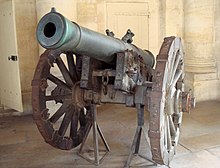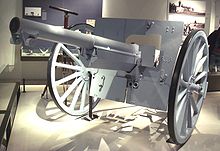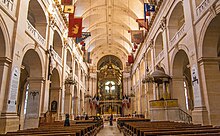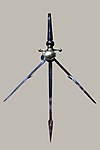Army Museum (Paris)
| Website | musee-armee |
|---|---|
The Musée de l'Armée (French:
The Musée de l'Armée was created in 1905 with the merger of the Musée d'Artillerie and the Musée Historique de l'Armée.[1] The museum's seven main spaces and departments contain collections that span the period from antiquity through the 20th century.
History
The Musée de l'Armée was created in 1905 with the merger of the Musée d'Artillerie and the Musée Historique de l'Armée.
In March 1878, the museum hosted an "
Significant holdings
The Musée de l'Armée has identified 24 aesthetic, technical and symbolic "treasures," which are all closely linked to French military history from the late Middle Ages through to World War II. They include weapons, armour, works of arts and technology.[3]
Main spaces
The museum consists of six main spaces.
Main Courtyard and artillery collections


The Main Courtyard is the centre of the Hôtel National des Invalides and displays a large part of the artillery collections, gathered during the French Revolution. The collection traces 200 years of the history of French field artillery and enables visitors to discover how the equipment was manufactured, its role and the history of great French artillerymen.[4]
Contains:
- 60 French classical bronze cannons
- A dozen howitzers and mortars
Armour and weapons, 13th–17th centuries

The Musée de l'Armée has a rich ancient collection, which makes it one of the three largest arms museums in the world.[5]
Contains:
- The Royal Room: crown collections
- The Medieval Room: artifacts from the feudal army to the royal army
- The Louis XIII Room: the progress of the royal army)
- A Themed Arsenal Gallery
- An exhibit on Courtly Leisure Activities (late Middle Ages to mid-17th century)
- some rooms of antique and oriental armament
Modern Department, from Louis XIV to Napoleon III, 1643–1870
This department covers the military, political, social and industrial history of France, reliving great battles, exploring the lives of soldiers, and tracing the development of technologies and tactics.[6]
Contains:
- Privates' uniforms
- Luxury weapons and arms
- Equipment of numerous French and foreign regiments
- Illustrious figures, such as Napoleon Bonaparte and his marshals[6]
Contemporary Department, the Two World Wars 1871–1945

The contemporary department tells the story of the French Army from 1871 to 1945, and the two great conflicts of the 20th century.[7]
Contains:
- French and foreign uniforms, including some having belonged to illustrious military leaders (Foch, Joffre, de Lattre, Leclerc, etc.)
- Objects used by soldiers in daily life
- Prestige pieces: marshals' batons and ceremonial swords:
- Emblems, paintings and elements from personal archives: letters, postcards, etc.[7]
The Charles de Gaulle Monument

The Charles de Gaulle Monument (Historial) is an interactive multimedia space dedicated to the work of Charles de Gaulle, the leader of the Free French Forces and founding President of the Fifth Republic.[8]
Contains:
- The Multi-Screen Room
- The Ring: "an overview of the century" projected onto a circular glass ring
- The Permanent Exhibition[8]
Cabinets insolites
Three cabinets are dedicated to special collections.
Contains:
- Artillery models from the 16th to 19th c.
- Military music instruments, selected among the 350 of the collection
- Military figurines, with 5000 toy soldiers displayed of a collection of 140000
The Army museum is associated with four additional spaces:
Musée de l'Ordre de la Libération
The museum is dedicated to the
Contains three galleries:
- Free France
- Interior Resistance
- Deportation
Musée des Plans-Reliefs

The Musée des Plans-Reliefs is a museum of
Cathedral of Saint-Louis des Invalides

In 1676, the Secretary of State for War,
Contains:
- The Veteran's Chapel[9]
Dôme des Invalides
The Dôme des Invalides is the emblem of the Hôtel National des Invalides and an unmissable monument in the Parisian landscape.[10]
Contains:
- The Dome Church
- The Tomb of Napoleon I[10]
Collection
-
The Sword of François I (16th century)
-
Olifant carved in an elephant tusk
-
Hunting crossbow
-
Set of cold weapons
-
Powder flask (Mid-16th century)
-
Priming flask (Circa. 1600)
-
The Saint-Gilles gun (1507)
-
Culverin called Wurtembourgeoise (End-16th century)
-
Bronze cannon said to be of Cardinal Richelieu, ca. 1600)
-
The Qianlong Emperor's armour (18th century)
-
37 mm TRP Mle 1916 rapid-fire infantry cannon
-
Taxi de la Marne (1914)
-
Renault FT17tank (1917)
-
V-2missile (1940s)
-
Luger pistol used in the (1930s)
See also
References
- ^ a b "Musée de l'Armée – Hôtel national des Invalides". Retrieved 17 April 2013.
- ^ a b c Gilles Aubagnac, "En 1878, les "sauvages" entrent au musée de l'Armée" in Zoos humains. De la Vénus hottentote aux reality shows, Nicolas Bancel, Pascal Blanchard, Gilles Boëtsch, Eric Deroo, Sandrine Lemaire, edition La Découverte (2002), p.349-354 (in French)
- ^ "Museum treasures". Retrieved 28 April 2013.
- ^ "The Main Courtyard and artillery collections". Archived from the original on 23 March 2013. Retrieved 17 April 2013.
- ^ "Old armour and weapons, 13th–17th century". Archived from the original on 16 April 2013. Retrieved 17 April 2013.
- ^ a b "Modern department, from Louis XIV to Napoleon III, 1643–1870". Retrieved 17 April 2013.
- ^ a b "Contemporary department, the Two World Ward 1871–1945". Retrieved 17 April 2013.
- ^ a b "The Charles de Gaulle Monument". Archived from the original on 22 March 2013. Retrieved 17 April 2013.
- ^ a b c "Cathedral of Saint-Louis des Invalides". Retrieved 17 April 2013.
- ^ a b "The Dome des Invalides". Retrieved 17 April 2013.















